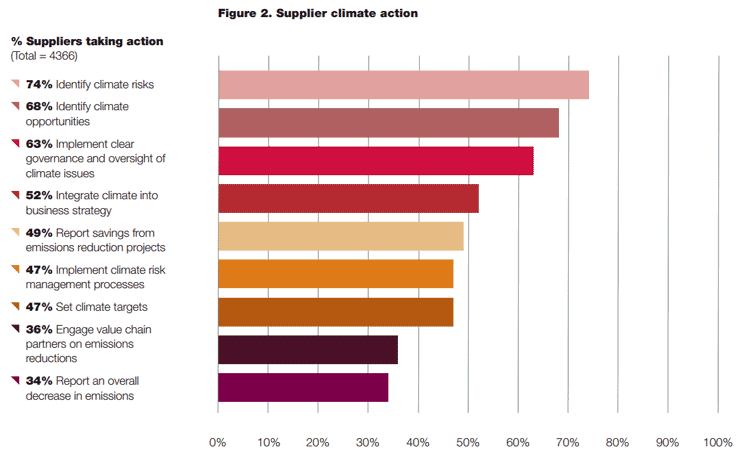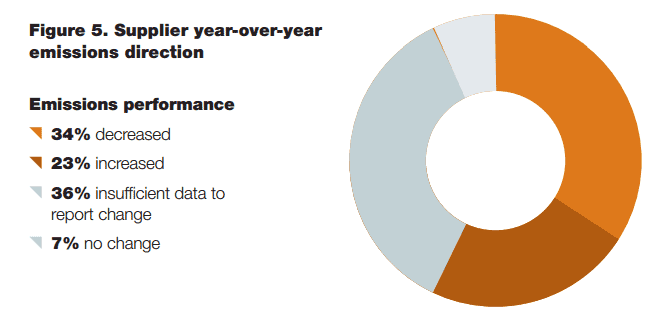The latest annual supply chain report from the UK's Carbon Disclosure Project (CDP) repeats the same theme as most recent years, finding some progress in the reduction of carbon emissions in the supply chain, but that the progress towards that goal is too slow and that not nearly enough companies are taking the sort of actions needed to accelerate declines in CO2.
The CDP surveys the suppliers of its 89 member companies, primarily large, multi-national firms across the globe, ranging from Dell and Coca-Cola to L'Oreal and Toyota. There is a detailed survey for larger suppliers, and a more abbreviate one for smaller supplier firms.
For this 2017 report, 8200 suppliers of the sponsoring companies received survey requests, resulting in completed surveys from 4366 of them.
From a big picture perspective, the report says that "Today a growing number of leading organizations, such as CDP's supply chain members, are developing an emerging body of knowledge and best practice on how to increase visibility and have a positive impact on their supply chain."
It adds that "Sustainability needs to move beyond organizational boundaries into the supply chain."
Despite what is characterizes as better progress on the climate front in 2016, "better is still not good enough," the CDP says, warning that "The sum of all current commitments leaves the world on a trajectory towards around 3.4 degrees Celsius of warming," a level many believe will lead to substantial environmental damage.
CDP does see progress in the data. For example, as shown in the graphic below, the research found 74% of respondents formally identify climate risks, and 68% identify climate opportunities (ways to reduce CO2), both up a bit from the 2016 report.
TheGreenSupplyChain.com notes all these numbers probably overstate the true conditions at these suppliers, as those responding to the survey were probably more likely to be more aggressive on climate-related practices than non-respondents.
However, just 34% of respondents actually reduced their C02 emissions in 2016.
The report says that consumer and business customer preferences for low carbon products were cited by respondents as opportunities to increase sales and create competitive advantage, though it does not quantify the level of such interest.
The report argues that "Leading companies can seize the value in this shift by exploring the emerging opportunities to differentiate themselves in a carbon-constrained economy."

Source: CDP
The research also found that in 2016, 2,151 suppliers report combined savings of $12.4 billion - double the savings reported in 2015 ($6.6 billion). Notably, almost half of the top 100 projects by savings were related to energy efficiency, indicating that substantial savings opportunities exist for companies that initiate energy efficiency projects. The majority of the projects (57%) had a payback period of 3 years or less.
That said, that still left over 2,000 supplier respondents that didn't have any emissions reduction initiatives in 2016, though some of that is from suppliers that have low carbon emissions to begin with.
Only about one-third of suppliers reported actual decreases in CO2 emissions in 2016, as seen in the chart below. 7% said their emissions remained the same, while 23% saw increasing emissions and 36% did not have the data to answer the question. So combined, 59% either saw emissions rise or did not have enough data to answer the question.

Source: CDP
As usual, the report includes some anecdotes on interesting activities on CO2 reduction by sponsor companies.
Intel, for example, last year added a requirement to complete CDP's climate change questionnaire to its Program to Accelerate Supplier Sustainability. That led Intel to achieve a 96% response rate to CDP's climate change questionnaire among its leading suppliers. Of these suppliers, 47% responded for the first time and 30% had a request to complete the survey only from Intel.
However, in 2016, just 23% of companies responding to the CDP Supply Chain questionnaire reported that they themselves engage with their own suppliers on GHG emissions and climate change strategies.
There is a lot more in the full report, which can be found here: 2017 CDP Supply Chain Report
Any reaction to this year's CDP report? Let us know your thoughts at the Feedback button below.

|